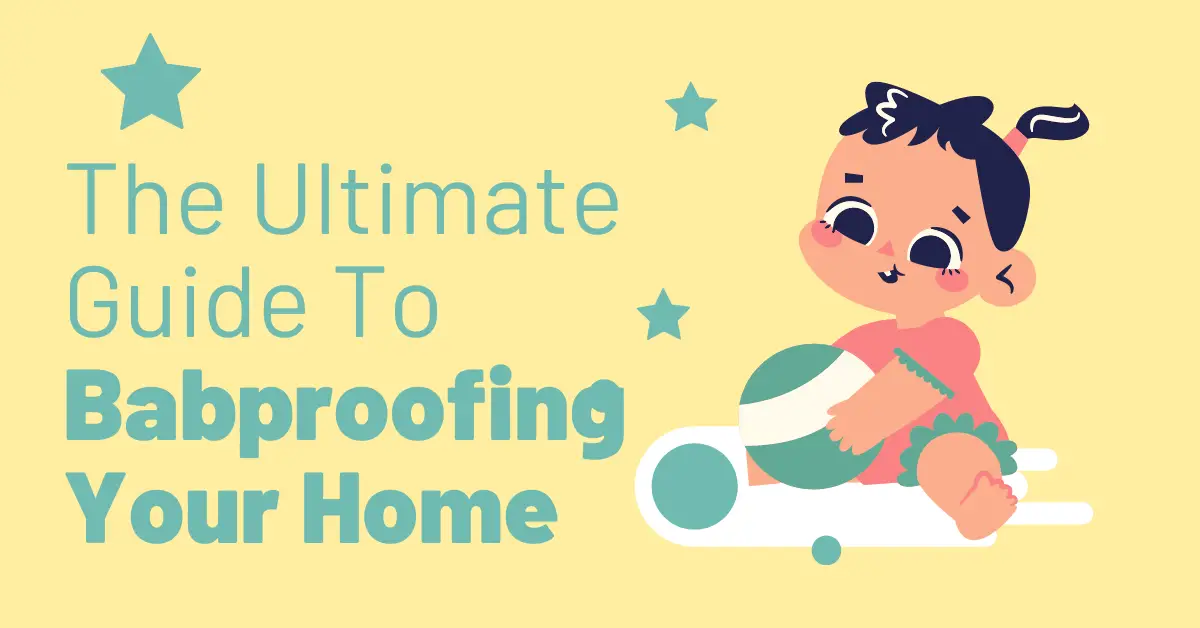Welcoming a baby into your home is one of the most joyous and transformative experiences of your life. It marks the beginning of a new chapter, filled with excitement, happiness, and countless milestones. However, it’s also a time of tremendous responsibility. This includes making sure that your home, a sanctuary for your family, becomes a safe haven for your little one. The process of babyproofing involves identifying potential risks and hazards in your living environment and making the necessary adjustments to minimize the chance of accidents. The importance of babyproofing cannot be overstated—it is an essential step in ensuring the safety of your baby as they begin to explore the world around them.
Babyproofing isn’t a one-time event but a dynamic process that evolves in line with your child’s development. As your baby grows and starts to explore their environment more, different hazards will become more pertinent. The babyproofing measures that are adequate for a newborn will not be enough once they start to crawl, walk, or climb.
Initially, your focus may be on creating a safe nursery and sleeping environment. However, once your baby starts to crawl, you’ll need to turn your attention to hazards that exist at ground level, including electrical outlets, loose cords, or small objects that can be swallowed. When your baby begins to walk and climb, additional precautions, such as anchoring furniture to the wall to prevent tipping, will be necessary.
Understanding these different phases will allow you to be proactive in your babyproofing efforts, ensuring your child’s safety at each developmental stage. In the following sections, we’ll delve into the details of how to babyproof your home effectively, covering various areas from the living room to outdoor spaces, and providing you with essential general tips and emergency preparation advice.
Disclaimer: This guide is intended to provide general information about babyproofing a home and is not a substitute for professional advice. Every situation is unique and may require a different approach to safety. We strive to provide accurate and up-to-date information but cannot guarantee its correctness, completeness, or suitability for individual circumstances. We disclaim all liability for actions taken or not taken based on this guide’s content and are not responsible for any direct, indirect, or consequential damages resulting from its use. Always consult with a professional for personalized advice.
Consult with the Experts
Benefits of Consulting with Home Design and Safety Professionals
While many aspects of babyproofing can be managed on your own, consulting with professionals in home design and safety can provide several advantages. These experts have extensive experience in identifying potential hazards that might not be immediately obvious to new parents. They can offer valuable insights into the most current safety products and techniques, and can even provide personalized recommendations based on your home’s layout. Furthermore, they can help ensure that your home remains aesthetically pleasing while still being safe, providing solutions that seamlessly integrate safety features into your existing decor. Investing in a professional consultation can be beneficial for your peace of mind, knowing that you’ve done everything possible to create a safe environment for your child.
Areas to Discuss with These Experts
When consulting with home design and safety professionals, there are several key areas you should focus on. These include your home’s overall layout, furniture arrangement, and the specific materials used in your home’s construction. You should also discuss any potential risks associated with different rooms in the house, such as the kitchen, bathroom, and nursery.
In addition to these, it’s crucial to address stairways and hallways, outdoor spaces, and any particular hazards that might be unique to your home, like fireplaces or balconies. It’s also a good idea to discuss the presence of pets in your home and how to manage interactions between your baby and these furry family members safely.
Lastly, don’t forget to discuss emergency preparedness. Understanding what to do in the event of a safety incident is equally as important as trying to prevent one from occurring in the first place. Professionals can guide you on important aspects like emergency exit plans, placement of safety equipment like fire extinguishers, and basic baby first aid.
Engaging in these discussions will ensure you’re well-equipped to babyproof your home effectively and handle any safety incidents that may arise.
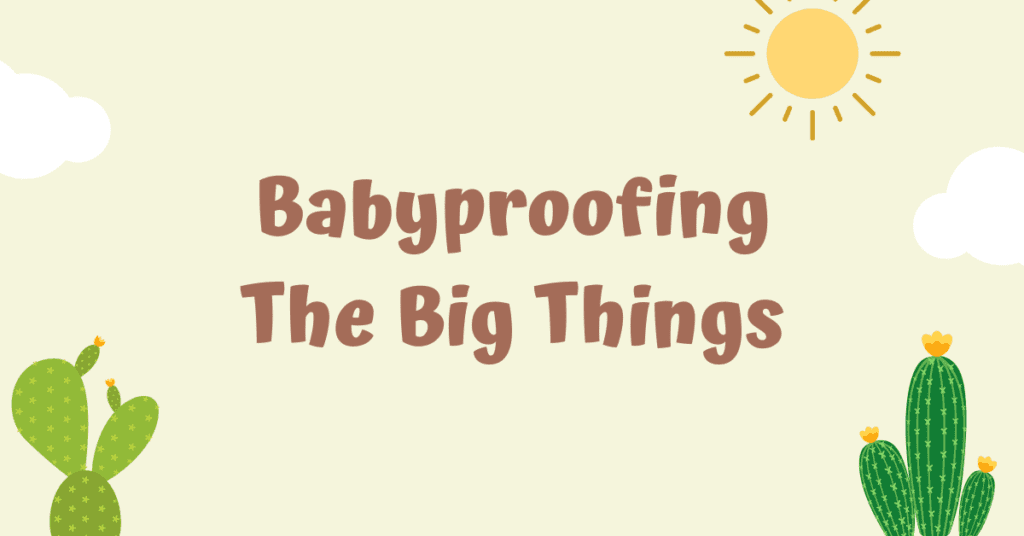
Babyproofing the Big Things
Addressing Major Household Repairs
When it comes to babyproofing, one of the first steps you should take is addressing any major household repairs. Broken tiles, shaky stairs, loose railings, or faulty electrical fixtures should be fixed as soon as possible. These repairs may seem like ordinary household chores, but they can pose significant risks to a curious baby or toddler. Remember, an environment that is safe for adults may not necessarily be safe for small children. By making sure everything in your house is in good working order, you are laying a solid foundation for your babyproofing efforts.
Importance of Smoke and Carbon Monoxide Detectors
Installing smoke and carbon monoxide detectors throughout your home is a crucial safety measure. These devices can literally be lifesavers, providing an early warning for potential fires or carbon monoxide leaks. Make sure you have detectors on each level of your home and in all bedrooms. Remember to test them monthly and replace their batteries annually, or as needed, to ensure they’re always in working order.
Dealing with Potential Lead Paint Issues
Homes built before 1978 may have layers of lead-based paint, which can be harmful if ingested or inhaled as dust. If you live in an older home, it might be worth having it tested for lead. If lead is found, hiring a certified lead-abatement professional to deal with it is crucial, as improper removal can lead to even more exposure. Never try to remove lead paint yourself.
Furniture Anchoring
As babies grow into toddlers, they begin to explore their environment in new ways, often by climbing. Unfortunately, this means furniture tipping can become a significant hazard. All furniture, such as bookcases, dressers, and televisions, should be anchored to the wall to prevent them from tipping over if a child attempts to climb on them. The best way to do this is by using furniture straps, brackets, or wall anchors. This small step can prevent serious injuries and is an important part of the babyproofing process.
Babyproofing the Living Room
How to Handle Sharp Corners
An open floor plan living room can be a wonderful space for your child to explore and play in, but it also comes with its own set of babyproofing challenges. Sharp corners, for instance, can be quite dangerous for babies who are learning to navigate their environment. Furniture with sharp edges or corners should be cushioned with corner protectors, which are easily available and simple to install. These protectors can significantly reduce the risk of injury from falls and bumps.
Choosing Baby-Friendly Furniture
The furniture in your living room should be chosen with care. Opt for pieces with rounded edges and corners instead of sharp ones. Also, choose furniture that is sturdy and less likely to tip over. Consider the materials too—some are easier to clean and more resistant to stains than others, which can be a big advantage with little ones around.
Managing Cables and Wires
Loose cables and wires can pose a serious hazard to babies and toddlers, who are often attracted to them out of curiosity. Electrical wires should be hidden behind furniture or secured to the wall where possible. You can also use cable management systems or cord covers to keep them out of sight and reach.
Using Childproof Coverings for Outlets
Electrical outlets are at the perfect height for crawling babies and toddlers to reach and can be a serious hazard if not properly babyproofed. Use safety plugs or outlet covers to keep these potential dangers out of little hands. Some covers even slide open automatically when you remove a plug, then close and lock when you’re done, offering an extra layer of protection. It’s also worth considering tamper-resistant receptacles, which have a built-in shutter system that prevents anything other than a plug from being inserted.
Babyproofing the Dining RoomImportance of Safe, Baby-Friendly Dining Tables and Chairs
The dining room, a central hub of family activity, requires careful attention when babyproofing. When selecting a dining table, consider one with rounded corners to prevent injuries from sharp edges. As for dining chairs, ensure they are sturdy and not easily tipped over. High chairs should meet safety standards, include a safety harness, and should not be placed near the table’s edge where a baby could push off and tip the chair backward.
Creating a Safe Eating Environment
Beyond the furniture, the dining environment itself should be designed with your baby’s safety in mind. Make sure tablecloths and placemats are not hanging too far off the table, as a baby can pull on them, causing dishes or hot food and drinks to spill.
Hot items and sharp utensils should always be placed out of a baby’s reach, even when seated in a high chair. Consider using unbreakable dishes and cups to avoid the risk of broken glass or ceramics. Finally, ensure small objects, which could be potential choking hazards, are kept away from the dining area.
Remember, supervision is vital, especially during mealtimes. Babies and young children should never be left unattended in the dining area, especially while eating, to prevent choking incidents and other accidents.
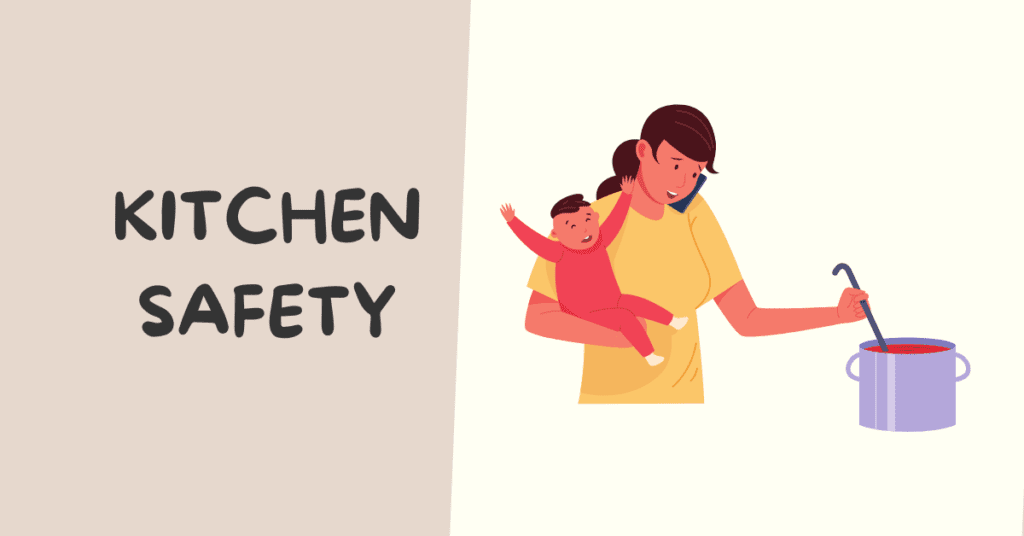
Kitchen Safety: Babyproofing the Kitchen
Locking Up Dangerous Items
The kitchen can be a hub of potential hazards for a curious baby or toddler. Anything sharp, like knives or scissors, and small objects that can be easily swallowed should be stored in high cupboards or locked drawers. Similarly, plastic bags and cleaning materials, including dishwashing liquids and detergents, should be kept out of reach or locked away. Child safety locks are a must for all accessible cabinets and drawers, preventing little hands from accessing harmful substances or dangerous utensils.
Stove-Knob Covers
Stove knobs can be quite attractive to little hands but can pose a real danger if your child manages to turn them on. Use stove-knob covers, which are designed to prevent little hands from turning the knobs. Consider also using a stove guard, a barrier that prevents children from reaching pots and pans on the cooktop.
Safe Storage for Cleaning Supplies
Cleaning supplies often contain chemicals that can be harmful or even fatal if ingested. Always store these items in a high cupboard or a locked cabinet. Never leave them out on countertops or under the sink where your child could easily access them.
Safe Location for Sharp Objects
Similar to cleaning supplies, sharp objects like knives, forks, and other kitchen tools should be kept in a safe location. Use high drawers or locked cupboards for these items. Consider using a magnetic knife strip installed high on a wall, out of reach of children. Ensure that appliance cords, such as those on toasters or blenders, are not left hanging over the edge of the countertop, as a child could pull on the cord and bring the appliance down on them.
Every kitchen is unique, so take the time to look around your kitchen and assess any potential hazards, taking steps to mitigate them. By doing this, you can create a safer environment for your child to explore as they grow and develop.
Bathroom and Laundry Room Babyproofing
Safe Storage for Medications and Cleaning Supplies
Bathrooms and laundry rooms often contain medications, cleaning supplies, and other potentially dangerous substances. These items should always be stored out of reach of children or in a locked cabinet. Childproof caps are not always enough to keep a determined toddler out of a medication bottle, so do not rely solely on them for safety.
Using Toilet Locks
To a curious child, a toilet can seem like a fun thing to play in, but it poses a serious drowning risk. Always keep the bathroom door closed, install a safety latch on the toilet seat, or consider using door knob covers that prevent little hands from being able to open the bathroom door.
Dangers of Electrical Appliances in These Rooms
Electrical appliances such as hair dryers, curling irons, or washing machines, can pose a significant risk if not used and stored properly. Always unplug these items after use and store them out of reach. Be particularly careful with appliances near water sources as they can lead to electric shocks if they get wet.
Avoiding Drowning Hazards
Never leave water standing in a bathtub or sink, even for a moment, as it only takes a few inches of water for a small child to drown. After use, always drain bathtubs, buckets, and any other large container of water. If you have a washer in your laundry room, always close its door when not in use to prevent a curious child from climbing in.
Remember, the most crucial aspect of safety in bathrooms and laundry rooms is supervision. Never leave a baby or toddler unattended in these spaces, even for a moment.
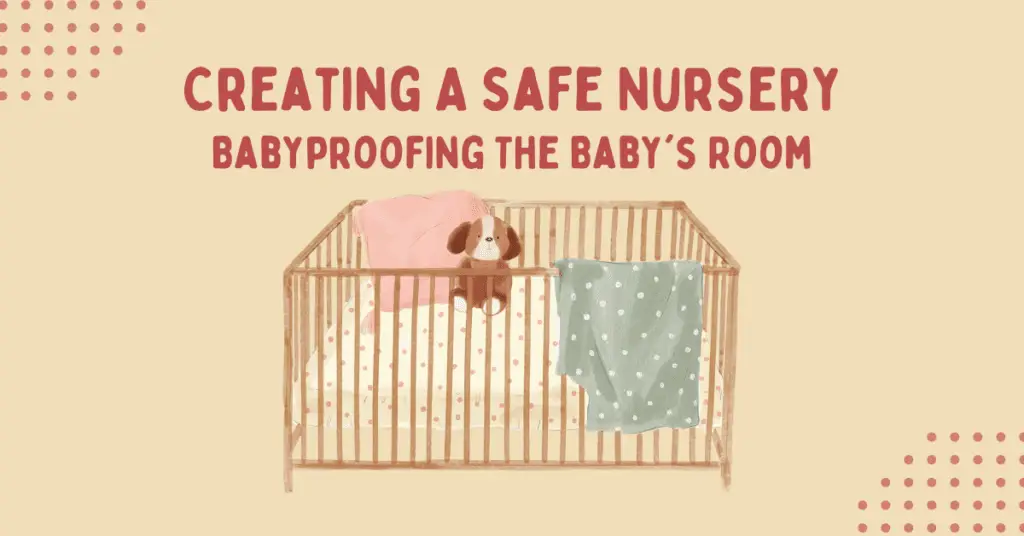
Creating a Safe Nursery: Babyproofing the Baby’s Room
Choosing Safe Nursery Furniture
Choosing the right furniture for your baby’s nursery is crucial. When selecting a crib, make sure it meets current safety standards. The slats should be no more than 2 3/8 inches apart to prevent your baby’s head from slipping through, and there should be no cutouts in the headboard or footboard. The mattress should fit snugly within the crib with no space for the baby to slip into.
Changing tables should have a safety strap and guardrails on all sides. Additionally, avoid placing the changing table near a window, blinds, drapes, or wall-mounted decorative items that your baby could reach.
Safe Storage for Toys and Accessories
Toys and accessories, while crucial for your baby’s development, can pose hazards if not stored properly. Large toys should be stored on the floor, not on high shelves or furniture where they could fall. Smaller toys should be kept in easily accessible, lightweight bins.
It’s essential to regularly check the condition of toys. Dispose of broken toys or those with sharp edges, loose parts, or peeling paint. Always consider the age appropriateness of toys; many toys for older children can pose a choking risk for younger ones.
Ensuring the Safety of Decorations
When it comes to nursery decorations, less is often more from a safety perspective. Avoid hanging heavy pictures or shelves over the crib, as they can pose a risk if they fall. Keep window cords out of reach, as they can be a strangulation hazard, and ensure windows are secured to prevent falls.
Importance of Regular Reassessment for Safety
As your baby grows, their abilities and interests will change, so it’s important to reassess the nursery’s safety regularly. What was safe for a newborn may not be safe for a curious crawler or an adventurous toddler. The newborn stage lasts about 2 months so be ready for when things quickly change. Regular reassessment will ensure that the nursery remains a secure place for your child at every stage of development.
Outdoor Spaces Safety
Making your Garden or Balcony Safe
Whether you have a large garden or a small balcony, it is essential to make these areas safe for your child to explore. In the garden, make sure all gates are secure, and fences are in good condition to prevent your child from wandering off. Remove or securely cover any water features like ponds or pools to prevent drowning hazards.
For balconies, install a safety gate at the entrance and ensure the railings are not wide enough for your child to squeeze through. Avoid placing furniture near the edge, as children can climb on them and possibly fall over the railings.
In both areas, be aware of plants. Some common plants can be toxic if ingested, so identify the plants in your space and remove any that could be harmful.
Safe Play Equipment
When choosing outdoor play equipment like swings, slides, or climbing frames, look for equipment that is age-appropriate and well-made. It should be securely anchored to the ground and located away from concrete or other hard surfaces. Consider using a shock-absorbing material like rubber mulch or mats underneath the equipment to soften any falls.
Securing Pools or Ponds
If you have a pool or pond in your garden, it’s critical to secure it. Install a fence that is at least 4 feet high around all sides of the pool, with a self-closing and self-latching gate. For added safety, consider a pool alarm that alerts you if someone enters the water. Remember, there is no substitute for active supervision when your child is near water.
In the case of ponds, consider covering them securely or fencing them off. As your child grows and learns to swim, remember to keep life-saving equipment nearby and learn what to do in case of emergencies.
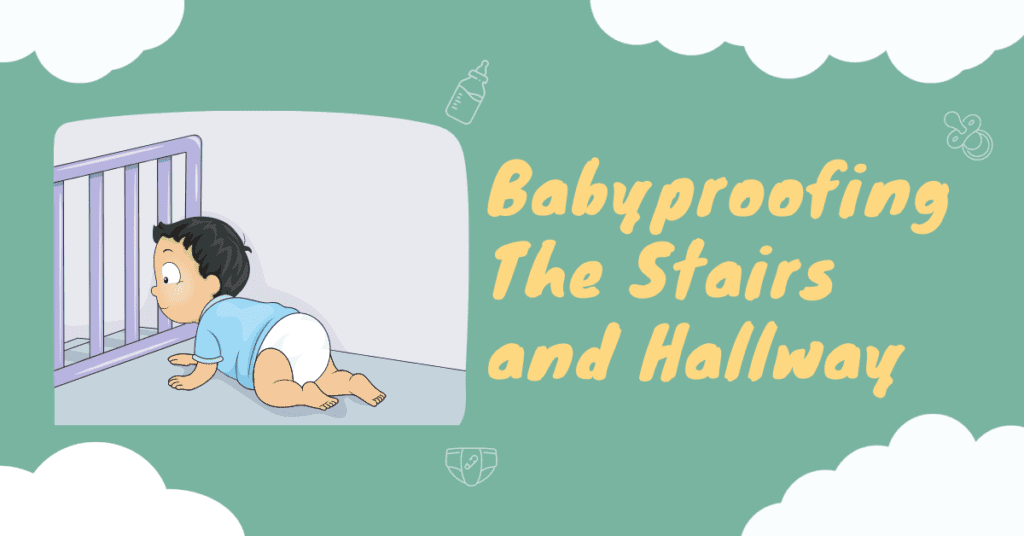
Babyproofing the Stairs and Hallway
Importance of Safety Gates
Staircases can be dangerous for children, especially those who are just learning to crawl or walk. Install safety gates at the top and bottom of staircases to prevent accidents. These gates should be securely mounted to the wall and have a locking mechanism that is difficult for a child to open. Remember, pressure-mounted gates are not suitable for the top of stairs.
Securing Loose Rugs
Loose rugs in hallways can easily cause slips and trips, both for little ones and adults carrying little ones. Make sure all rugs are secured with non-slip backing. If possible, avoid having loose rugs in areas where your child frequently plays or crawls.
Keeping Hallways Well-lit
Good lighting is essential for safety, especially in areas like hallways and staircases. Install enough lighting to keep these areas well-lit at all times, and consider using nightlights for added safety during the night or early morning hours. This way, you can easily check on your child during the night, and older kids can safely navigate if they wake up.
With these precautions in place, you can significantly reduce the risk of accidents in these high-traffic areas of your home.
Pet Safety
Securing Pet Food and Toys
While pets add a layer of love and warmth to your home, their food and toys can pose hazards for your baby. Pet food, whether wet or dry, can be a choking hazard and should be kept out of reach of your child. After your pet finishes eating, clean up any leftover food and store the pet food containers in a secure place.
Similarly, small pet toys can pose a choking risk for babies and toddlers. Keep pet toys in a specific area that your child cannot access, and remember to put them away after your pet finishes playing with them.
Managing Interactions between Pets and Baby
Interaction between your baby and pets should always be supervised. Teach your pets boundaries regarding the baby’s space and gradually introduce the baby to them to avoid any sudden changes in the pet’s behaviour. Simultaneously, as your child grows, teach them how to interact gently with the pet, not to disturb them while eating or sleeping, and to stay away from the pet’s toys.
Pets can provide wonderful companionship for children, but it’s crucial to manage their interactions carefully to ensure the safety of both the child and the pet. Taking these steps will help create a harmonious relationship between them.
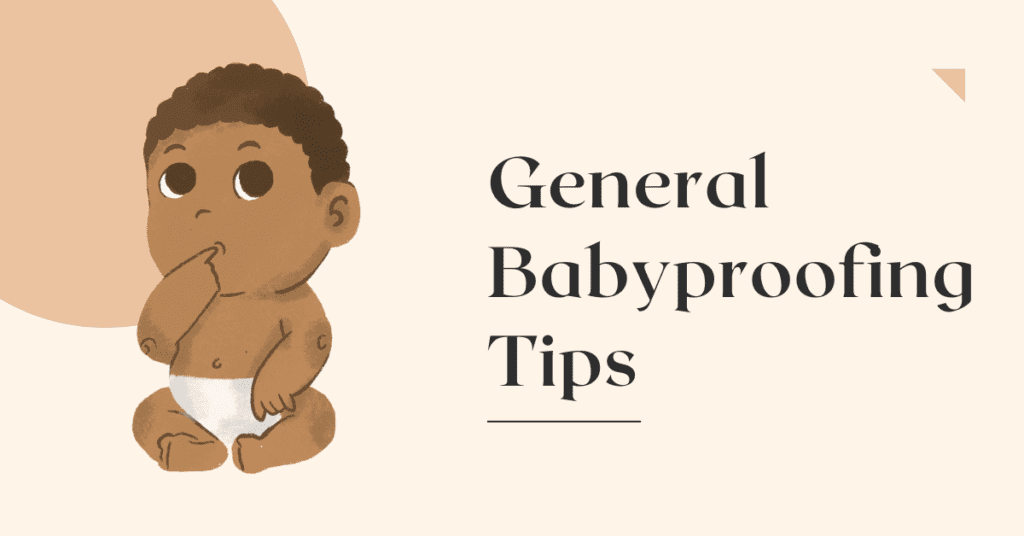
General Babyproofing Tips
Importance of Regular Sweeps for Hazards
Regular sweeps around your home to identify and remove potential hazards are crucial. Babies and toddlers are naturally curious and quick to explore their surroundings, so making sure that your home is as safe as possible is paramount. From removing small objects that could pose choking hazards to ensuring that all cabinets and drawers are securely locked, consistent checks will help keep your child safe.
Keeping Small Objects Out of Reach
Items like coins, jewellery, buttons, or batteries are small enough for a child to choke on and should be kept out of reach. Be mindful of objects on low tables, countertops, and any area within your child’s reach. Also, ensure to keep purses or bags that could contain hazardous items out of reach.
Safely Storing Batteries and Other Hazardous Items
Batteries, especially button batteries, can cause severe harm if swallowed. They should be stored in a secure location and ensure that items using these batteries are either out of reach or have a battery compartment that is secured with a screw.
Other hazardous items include alcohol, laundry pods, and e-cigarettes. These items are often overlooked but can be very harmful if ingested by a child.
Ensuring Your Houseplants Are Non-Toxic
Houseplants can brighten up a room, but some can be poisonous if ingested. Do some research to make sure that your houseplants are non-toxic. If you do have poisonous plants, either remove them or place them in an area where your child cannot reach them.
Overall, babyproofing requires ongoing vigilance and effort, but these steps will go a long way in ensuring your home is a safe place for your child to explore and grow.
Emergency Preparation
Keeping Emergency Numbers Accessible
It’s crucial to keep a list of emergency phone numbers in an easily accessible location. This list should include numbers for your local poison control centre, your child’s pediatrician, the nearest hospital, and other key emergency contacts. Save these numbers in your phone and consider posting a physical copy on your refrigerator or another prominent place.
Understanding Basic Baby First Aid
Every parent or caregiver should have a basic understanding of infant and child first aid. This includes knowing how to perform CPR, how to help a choking baby or toddler, and how to handle basic injuries. Numerous organizations offer infant and child first aid courses, many of which are available online.
Also, consider keeping a well-stocked first aid kit at home and in any vehicle your child regularly travels in. The kit should include items such as band-aids, antiseptic wipes, tweezers, a digital thermometer, and a list of emergency phone numbers.
Importance of Regular Safety Check-ins
Regular safety check-ins are essential to ensure your babyproofing measures are still effective as your child grows and their abilities develop. These check-ins should involve inspecting safety equipment like gates, locks, and outlet covers, and ensuring furniture and appliances remain secure. It’s also a good opportunity to look for new hazards as your child begins to move and explore in different ways.
Emergency preparation is an important part of babyproofing your home. While you hope to never need to use this preparation, being ready to handle an emergency can make a significant difference when every second counts.
Wrapping Up The Ultimate Babyproofing Guide
Babyproofing your home is not a one-time event but a continuous process. As your child grows and learns new skills, new hazards may emerge. Remaining vigilant means always being aware of the potential dangers and actively working to mitigate them. Your home is a place for your child to explore, learn, and grow, and ensuring it’s safe is one of the most significant ways you can support their development.
Babyproofing is fluid and will change as your child grows. The safety measures necessary for a newborn will be different from those for a crawler, a toddler, or a preschooler. As your child reaches new milestones, reassess your babyproofing strategies and make the necessary adjustments.
Your ultimate goal is to strike a balance where your child can safely explore their environment, thus promoting their independence, while ensuring they are protected from significant harm.
In conclusion, while babyproofing may seem like a daunting task, taking it one step at a time and staying informed about potential hazards can help you create a safe and nurturing space for your child to thrive. By following these guidelines and adapting to your child’s changing needs, you’ll be well on your way to providing a safe environment where your little one can explore with confidence.

